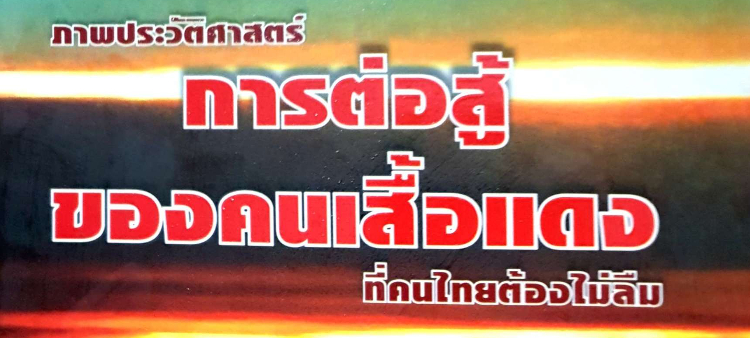
ภาพประวัติศาสตร์ การต่อสู้ของคนเสื้อแดง ที่คนไทยต้องไม่ลืม (‘pictures of the red-shirt fight that Thais must not forget’), published in 2011, covers the United Front for Democracy Against Dictatorship (red-shirt) protests and ensuing military crackdown from a decidedly red-shirt perspective. The book was published by PTV, the satellite television station set up by former Thai Rak Thai party members to compete with yellow-shirt leader Sondhi Limthongkul’s ASTV channel.
Despite its glossy paper, the book feels cheaply made: many of the photographs are printed at a low resolution, and the binding is of poor quality. Also, there are some especially gruesome photos, with one page in particular (p. 17) lingering on the most horrific imagery. (There are brief sections on the 14th October 1973, 6th October 1976, and May 1992 massacres, for historical context.)
Links between PTV and former prime minister Thaksin Shinawatra were always denied, though he was widely assumed to be the station’s main financial backer. The book is essentially a Thaksin hagiography: it’s almost as fawning as ทักษิณ Where Are You? (‘Thaksin where are you?’). ราษฏร์ประสงค์ ๒๕๕๓ (‘Ratchaprasong 2010’) and ความจริงวันนั้น (‘the truth about that day’) are also pro-Thaksin accounts of the red-shirt protests.
If Thaksin is the hero of this narrative then Abhisit Vejjajiva is very much the villain. The book directly blames Abhisit for the crackdown, as he was prime minister during the 2010 protests. The documentaries The Terrorists (ผู้ก่อการร้าย) and Democracy After Death (ประชาธิปไตยหลังความตาย) also point the finger at Abhisit personally, though he denied any culpability in his memoir The Simple Truth (ความจริงไม่มีสี).
Two books published by liberal journals, 19–19 ภาพ ชีวิต และการต่อสู้ของคนเสื้อแดง จาก 19 กันยา 2549 ถึง 19 พฤษภา 2553 (‘pictures of the life and struggle of the red-shirts from 19th September 2006 to 19th May 2010’) and กรุงเทพฯ (ไม่) มีคนเสิ้อแดง (‘Bangkok (no) red shirts’), cover the red-shirt protests with more objectivity. Bangkok, May 2010 provides analysis of the period from both sides of the red/yellow political divide.
Despite its glossy paper, the book feels cheaply made: many of the photographs are printed at a low resolution, and the binding is of poor quality. Also, there are some especially gruesome photos, with one page in particular (p. 17) lingering on the most horrific imagery. (There are brief sections on the 14th October 1973, 6th October 1976, and May 1992 massacres, for historical context.)
Links between PTV and former prime minister Thaksin Shinawatra were always denied, though he was widely assumed to be the station’s main financial backer. The book is essentially a Thaksin hagiography: it’s almost as fawning as ทักษิณ Where Are You? (‘Thaksin where are you?’). ราษฏร์ประสงค์ ๒๕๕๓ (‘Ratchaprasong 2010’) and ความจริงวันนั้น (‘the truth about that day’) are also pro-Thaksin accounts of the red-shirt protests.
If Thaksin is the hero of this narrative then Abhisit Vejjajiva is very much the villain. The book directly blames Abhisit for the crackdown, as he was prime minister during the 2010 protests. The documentaries The Terrorists (ผู้ก่อการร้าย) and Democracy After Death (ประชาธิปไตยหลังความตาย) also point the finger at Abhisit personally, though he denied any culpability in his memoir The Simple Truth (ความจริงไม่มีสี).
Two books published by liberal journals, 19–19 ภาพ ชีวิต และการต่อสู้ของคนเสื้อแดง จาก 19 กันยา 2549 ถึง 19 พฤษภา 2553 (‘pictures of the life and struggle of the red-shirts from 19th September 2006 to 19th May 2010’) and กรุงเทพฯ (ไม่) มีคนเสิ้อแดง (‘Bangkok (no) red shirts’), cover the red-shirt protests with more objectivity. Bangkok, May 2010 provides analysis of the period from both sides of the red/yellow political divide.

